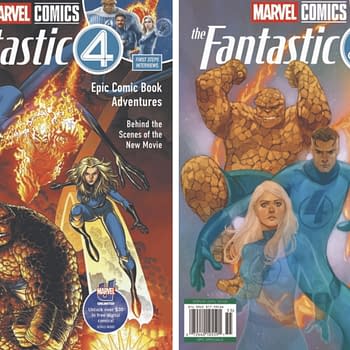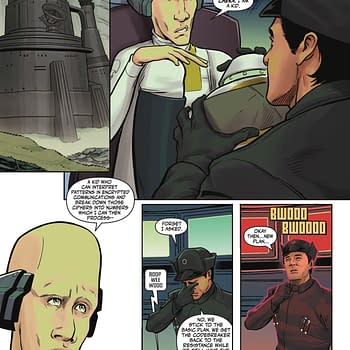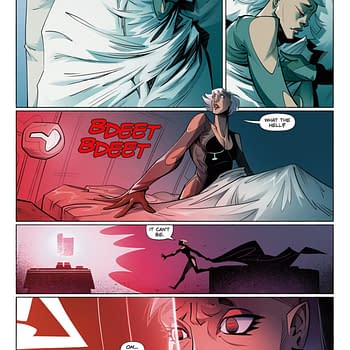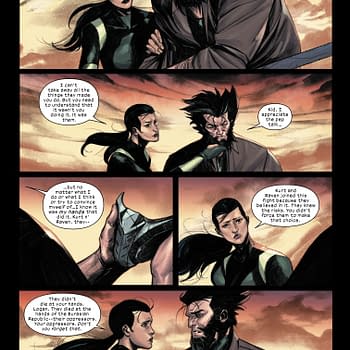Posted in: Comics | Tagged: age of ultron, all new x-men, battle of the atom, brian bendis, Comics, dan slott, marvel, spider-man 2099, superior spider-man, x-men
The New Marvel Rules Of Time Travel – Courtesy Of Battle Of The Atom (SPOILERS)
WARNING: There are spoilers today's for X-Men: Battle Of The Atom and All New X-Men below. Even a bit of Superior Spider-Man. You may want to read the comics first, then pop back. I would.
Editor-In-Chief Mark Gruenwald established the rules first. Whenever anyone in the Marvel Universe travels back in time, they get shunted into a parallel universe, so as not to affect the present day. We run them at the bottom of the piece.
This is clearly no longer the case. But the rules of time travel are still up in the air.
In Age Of Ultron, written by Brian Michael Bendis, Wolverine and The Invisible Woman went back in time to kill Ant Man, and then found the present day totally changed – as well as new versions of themselves. But neither the original Logan or Susan were wiped out by the new continuity, they existed alongside it. And when Logan went back in time again to fix things, that ended up wiping out the second continuity (and the Susan that he left there), stopping his earlier self from killing, rescuing that Susan and coming back to the new timeline with an extra Wolverine, giving us three Wolverines, and two Invisible Women. One of the Wolverine's killed the other, because, well, we'll get back to you on that. And we're told that the remaining extra Wolverine and Invisible Woman somehow were deleted by the timequake. Possibly. It was all very up in the air.
Now, we have the All New X-Men, the original X-Men from the sixties (or now, probably from somewhere around 2000) in the current day. And getting involved in all sorts of stuff. So the inevitable happens…
Love the blur effect for either a) the confusion and uncertainty caused by the event or b) some kind of time travel jiggling is going on.
But now? Now we've switched to Looper rules. Now, you kill someone's past self and their future self disappears. But somehow everyone remembers them and history doesn't seem to be affected, not instantly at least. You bring them back to life and…
And on its resolution, it snaps back with that crisp clear Frank Cho-ness. But there we go. The Marvel rules of time travel, completely changed, and appearing on panel. And suddenly making things very dangerous. Even if the actual characters don't want to actually admit what happened.
A coma wouldn't have deleted his present day self though. Although, here's another thing, the presence of Present Cyclops wouldn't have affected whether or Christopher would have tried to heal Past Cyclops. He would have done it anyway. So why did Present Cyclops have to disappear, apart from dramatic reasons? The new rules of Marvel time travel appear to be "Whatever looks cool". Which isn't bad per se… but obviously a geek like me will get annoyed by that.
So, of course, with this kind of danger, The All New X-Men have to go home…
Which is all fine and lovely. But what stops this from happening? The arrival of a bunch of Future X-Men…

Yes, Mr Xavier lookalike, that's exactly what the Present Day X-Men were going to do with the Past X-Men. And the reason that this doesn't happen? Because the Future X-Men turned up and we got a fight scene. They literally stopped what was going to happen anyway, in an attempt to make it happen. They created their own nemesis.
This is consistent with the fixed rules of time travel which state that nothing can be changed, it all plays out the same way, regardless. Except the disappearance of Present Cyclops totally negates that. And also it means that the Future X-Men have to all be carrying the Idiot Ball, including Hank McCoy, to decide to travel to the Present to prevent something that their presence causes.
Which is kinda cool. But makes no sense whatsoever.
Meanwhile, over in Superior Spider-Man, Dan Slott is of the fixed event school of time travel, it seems.
See, I think that's kinda cool. Superior Spider-Man, X-Men: Battle Of The Atom and All-New X-Men are published today by Marvel Comics.
Mark Gruenwald's Rules Of Time Travel from Marvel Age, 1992.
One of the more interesting aspects of my job as Senior Executive Editor is I was the one who got to research, work out, and write up the rules pertaining to time travel in the Marvel Universe for our in-house editors' policy handbook. Before I came on the scene, Marvel– a publishing outfit which prides itself on its internal consistency– was a wee bit relaxed when it came to how time travel worked. Writers were free to have it work every which way (including loose) with no regard to what had already been established. Once I was designated consistency cop, it was up to me to develop the rules of M.U. time travel using the consensus of information. It was a job I must admit I relished since, ever since my self-published fanzine days, I was interested in the way fictional realities worked. So, printed here for a general audience for the first time are Marvel's official rules of time travel…
Time travel should be used very sparingly in order to keep the phenomenon as special as possible. To ensure that future usage of the phenomenon are kept consistent with the majority of past usages, observe the following principles:
1. The Marvel Universe is part of a multiverse (a system of related universes) which diverge from one another at critical junctures.
2. The act of time travel always produces a critical juncture diverging a new alternate timeline or world at the moment one enters the reality of another time period, past or future of the time period set out from. It creates one timeline where an extratemporal person or element materialized via time travel, and one 'virgin' timeline where that person or element did not.
3. Because it is impossible to travel to the 'virgin' timeline, and because divergent timelines are dimensionally displaced from one's root timeline, all time travel actually involves dimensional travel. A time traveler does not truly travel straight backwards or forwards in time, but backwards or forwards and a bit off to the side to a divergent timeline now running parallel to one's timeline of origin. Since this timeline will have been identical to the 'virgin' timeline until the moment of divergence, there will be virtually no differences between the two timelines until most time travelers have no reason to be aware that they are not on the 'virgin' timeline.
4. If one travels a second time to an era one has already been to, one will not materialize on the 'virgin' timeline nor the timeline diverged by one's previous trip, but a third timeline diverged from one or the other. A time traveler can never travel back to the exact same timeline more than once. Again, since the second and third divergent timelines are identical until the time traveler's arrival, they will be indistinguishable at first.
5. When one travels a second time to any era in which one already exists, it will be possible to meet a temporal counterpart of one's self already there. A new counterpart diverges into being every single time a time traveler travels to a timeline one already exists in. Subsequently, multiple temporal counterparts could co-exist through multiple time trips to the same time period.
6. The co-existence of mulitple counterparts of the same being on one timeline does not cause time paradoxes. Time paradoxes are only possible in single timeline universes.
7. Altering an incident in the past will indeed affect the future reality of the timeline diverged by the time traveler's presence. One can create any number of different divergencies by one's significant actions, the act of time travel being but the first. Whether one will be able to return to the present of the timeline where one did no reality-tampering divergences or one which diverged as a consequence of one's past actions is a function of the means of time travel.
8. Returning to one's present also creates a divergent reality. If one has been gone any length of time, one may find differences have accumulated in accordance with the length of time one was away.
9. Selective alterations in the present as a consequence of the time traveler's actions in the past do not occur. An alteration in the past will create an entirely new timeline with events proceeding smoothly from the point of divergence. To the denzins of that timeline's 'present', the past is a continuous series of events that always happened as they happened. Were one to see selective dematerializations, they would either be caused by something other than the act of time travel unto itself or would be hallucinations.
10. There are three possible methods of time travel in the Marvel Universe: a. Time travel machines (Dr. Doom, Kang). b. Magic (Dr. Strange, Thor's hammer). c. Personally generated energy (Silver Surfer).
All methods involve generating 'chronal displacement inertia' freeing one's chronological position in the timestream (just as escape velocity frees one from earth's gravitation), skimming through the extra-temporal realm outside the timestream (Limbo), and re-entering the timestream at another chronological position. Because no time exists outside the timestream, the perceived duration of the passage through limbo may be anything from non-existent to an eternity.
11. If any of the above is confusing to you or your writers, you may ask the Senior Executive Editor for clarification. If it still is confusing, you should not be doing a time travel story. The above principles only apply to the Marvel Universe; other fictional realities may have other rules of time travel.
That's it, the full text of the Time Travel section in the Marvel editors' handbook. Despite the occasional technical term or two, this is as clear and most straightforward I can be on this admittedly difficult subject. Like any set of rules, they can be perceived as stifling, depending on a writer's mindset. Some writers are in love with the idea of paradox and keep thinking they've discovered a new paradox so cool it deserves to be put in a Marvel mag. Personally, I find the rules reassuring, but I'm a wee bit prejudiced. I've done a few stories involving time travel, including one in two of this summer's annuals (no plug allowed), and I find the guidelines both easy and fun to work within.
Comics courtesy of Orbital Comics, London. This weekend, launching their gallery by photographer Steve Cook of Sophie Allred, in the Doctor Who years.





















